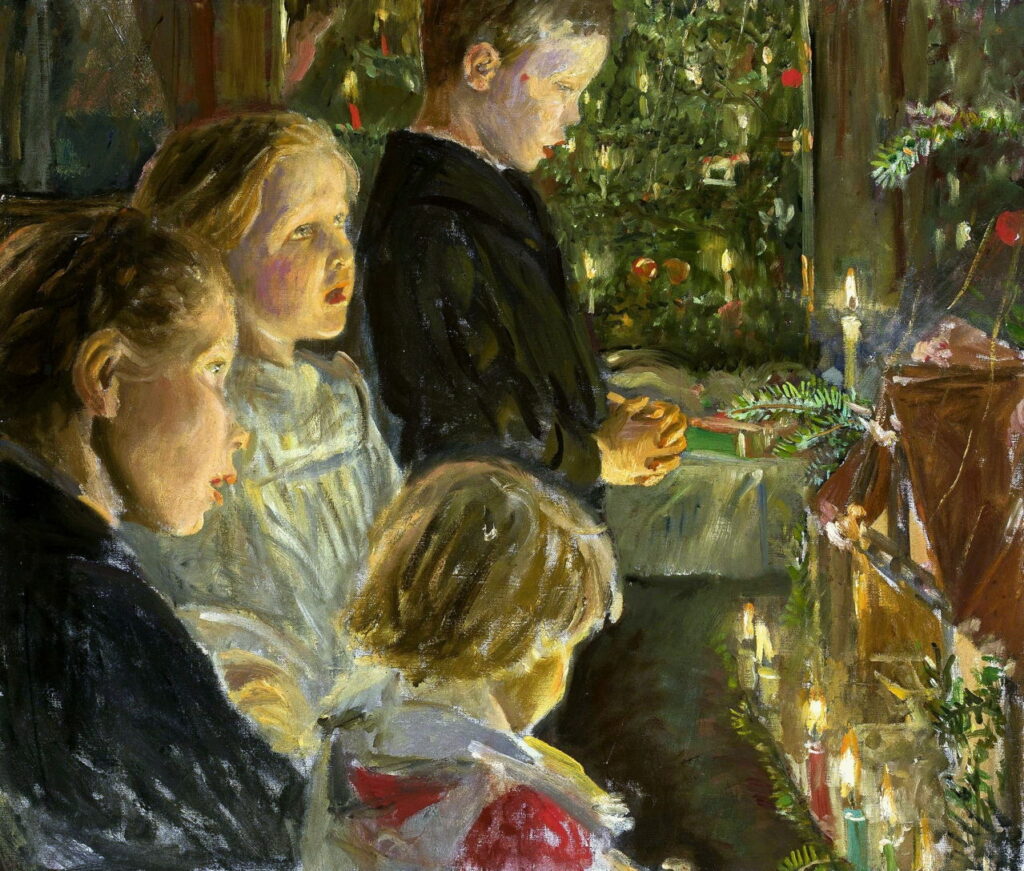Christmas Eve in paintings

Western Christmas traditions are rich and varied, and many that we now take for granted are surprisingly recent innovations. To celebrate the major feast and festival of the Western year, I bring two articles about paintings: this looks at events on the day and evening prior to Christmas Day, what’s normally known as Christmas Eve. Tomorrow’s article considers the origins of traditional Nativity paintings.
Wherever you go in the world, the feast of Christmas is now associated with decorated trees, which is a relatively recent tradition outside Germany where they originated and became popular as late as the nineteenth century. That compares with Nativity scenes, plays and cribs which had originated in the fourteenth century and quickly spread across Europe.
In the early nineteenth century, following marriages between German royalty and those of other European nations, Christmas trees started to appear across Europe. They reached Britain by 1800, Denmark a few years later, and Austria in 1816. They became more generally popular as a result of Queen Victoria’s fondness for them, and from the 1840s swept Europe, then North America.
Hans Andersen Brendekilde (1857–1942), Cutting Christmas Trees (1885), oil on canvas, 96 x 121 cm, location not known. Wikimedia Commons.
Nordic countries had a plentiful supply of suitable trees. Hans Andersen Brendekilde’s finely detailed Cutting Christmas Trees from 1885 shows the men and boys of Danish families preparing some for their homes.
Carl Wenzel Zajicek (1860–1923), Christmas Market in Am Hof Vienna (1908), watercolour on paper, 30.5 x 40 cm, location not known. Wikimedia Commons.
Those who couldn’t go off to the woods to cut their own Christmas trees bought them in one of the seasonal markets that set up in most towns, as shown in Carl Wenzel Zajicek’s watercolour of the Christmas Market in Am Hof Vienna from 1908. This is the largest square in the centre of Vienna, and still hosts a large seasonal market.
Alphonse Mucha (1860-1939), Christmas in America (1919), oil on canvas, dimensions not known, Musée du Luxembourg, Paris. Image by Jean-Pierre Dalbéra, via Wikimedia Commons.
Alphonse Mucha’s Christmas in America from 1919 alludes to the Christmas tree in the greenery and decorations. That year, Mucha had realised his great ambition of exhibiting his series of twenty paintings depicting the history of the Slav peoples, his Slavic Epic, in Prague, which had only the previous year become the capital of newly independent Czechoslovakia. His decade of work on this series had been supported by the American Charles Crane, whom he celebrated by this painting.
Viggo Johansen (1851–1935), Christmas Eve (Study) (1891), oil on canvas, 58 x 63 cm, location not known. Wikimedia Commons.
Other artists saw the merits of depictions of children responding to the tree, and the opportunity to play with light. Another Danish artist and member of the Skagen group of Impressionists, Viggo Johansen painted this wonderfully loose study for a finished painting of Christmas Eve in 1891.
Because of an earlier family tragedy, Johansen had been banned from dancing around the family Christmas tree when he was a child. When he came to have his own family, he went out of his way to ensure that his six children weren’t so deprived. That year he bought one of the largest Christmas trees in Copenhagen, and painted his family celebrating the feast around it. That took him about four months, during which the tree shed most of its needles, and his family had to keep attaching freshly cut branches to it to maintain its appearance.
Leopold Graf von Kalckreuth (1855–1928), Children by the Christmas Tree (c 1912), oil on canvas, 41.5 × 49 cm, Muzeum Narodowe w Warszawie, Warsaw, Poland. Wikimedia Commons.
Leopold Graf von Kalckreuth brings together what has since become a cliché in his sentimental group of Children by the Christmas Tree from about 1912.
Lovis Corinth (1858–1925), Christmas Decorations (1913), oil on canvas, 120 × 80.5 cm, Lentos Kunstmuseum Linz, Linz, Austria. Wikimedia Commons.
On Christmas Eve at the end of 1913, almost exactly two years after his severe stroke, Lovis Corinth painted this delightful scene of their two young children enjoying their Christmas Decorations. The artist’s wife Charlotte is seen disguised as Father Christmas at the left edge. Their son Thomas stands with his back to the viewer in front of a nativity scene close to his mother. Daughter Wilhelmine is at the right edge, inspecting one of the presents.
Sophie Gengembre Anderson (1823–1903), Christmas Time – Here’s The Gobbler! (date not known), oil on canvas, 112 × 84 cm, Private collection. Wikimedia Commons.
In the less commercial past, Christmas Eve was also the day of final preparations for the feast, when more affluent families across Europe might bring home the turkey ready to cook. Sophie Gengembre Anderson captures the unwilling victim in her undated Christmas Time – Here’s The Gobbler!
Nikolai Astrup (1880–1928), Christmas Eve at Sandalstrand (1918), woodcut print on paper, 33.8 x 50.5 cm, Private collection. The Athenaeum.
In Nikolai Astrup’s woodcut print of his family’s Christmas Eve at Sandalstrand from 1918, his wife and young son have fallen asleep exhausted, amid traditional Norwegian decorations, including a well-decked tree.
Carl Larsson (1853–1919), Christmas Eve (1904), watercolour, dimensions not known, location not known. Wikimedia Commons.
For others, the night before Christmas marks the high point of feasting and celebration. Carl Larsson’s Christmas Eve from 1904 shows his large extended family gathering in grand style, with a huge turkey, a roaring fire, and a cat under the table, trying to get into the party.
Christmas Eve has a different significance for those unable to celebrate the occasion in such style.
Wojciech Kossak (1856–1942), Soldiers’ Christmas (1915), oil on canvas, 82 × 72 cm, location not known. Wikimedia Commons.
In 1915, when the whole of Europe was engulfed by the Great War, Wojciech Kossak painted this Soldiers’ Christmas. The decorations on the small Christmas tree in the foreground echo the uniforms in their greyness. In the sky, a shellburst acts as a metaphor for the guiding star which led the Magi to the infant Jesus in Bethlehem, but below that celestial light these infantry soldiers fight on.
Christmas has also been a time for more formal charity. Rather than giving one another expensive presents, many have given to the poor and needy.
Carl Oesterley junior (1839-1930), Queen Marie of Hanover Giving Presents to the Poor and Needy (1908), oil, dimensions and location not known. Wikimedia Commons.
The younger Carl Oesterley captured history in his painting of Queen Marie of Hanover Giving Presents to the Poor and Needy (1908). Princess Marie of Saxe-Altenburg, as I believe she’s more properly known, lived between 1818-1907. The artist’s father, Carl Oesterley senior, had been court painter to her family, but in 1866 her father’s kingdom was annexed by Prussia. The Princess married King George V of England, and her family never relinquished the throne. Princess Marie is shown as a saintly figure, bathed in light as the poor and needy, including a sick boy in the bed behind her, worship her grace. She also has at least three Christmas trees in the background, which seems a little excessive even for royalty.
Christian Krohg (1852–1925), Seamstress’s Christmas Eve (1921), oil on canvas, dimensions not known, Nordnorsk Kunstmuseum, Tromsø, Norway. Wikimedia Commons.
The Norwegian Naturalist Christian Krohg uses a Christmas tree to tell the story in his Seamstress’s Christmas Eve from 1921. A young woman is in her garret bed-sit, where she has been toiling long hours at her sewing machine. An affluent couple, relatives or employers perhaps, have just arrived to give the young woman a Christmas tree, a large wicker basket of presents, and more. Maybe that young woman can still be saved from the fate brought on by her sweated labour at the sewing machine, and her inevitable decline towards prostitution, an unusual way to spend Christmas Eve.
Jacek Malczewski (1854–1929), Christmas Eve in Siberia (1892), oil on canvas, 81 x 126 cm, Muzeum Narodowe w Krakowie, Kraków, Poland. Wikimedia Commons.
Traditionally, Christmas has been a time to think of those less fortunate than ourselves, which is exactly what Jacek Malczewski does in his Christmas Eve in Siberia from 1892. The men here are Polish, deported from their native country and imprisoned in the extreme cold and remoteness of Siberia. Although there’s a steaming samovar at the end of the table, they have only had soup and a wedge of bread for their seasonal feast. Following the Polish Uprising in 1863, at least 18,000 were ‘exiled’ to Siberia, many of whom never returned.
Henri Jules Jean Geoffroy (1853–1924), Jean Valjean and Cosette (1879-1882), oil on canvas, dimensions not known, Maison de Victor Hugo, Paris. Wikimedia Commons.
Around 1879-1882, Henri Jules Jean Geoffroy painted this work showing a well-known scene from Victor Hugo’s Les Miserables, of Jean Valjean and Cosette. This shows the hero Valjean when he arrives in Montfermeil on Christmas Eve and discovers young Cosette fetching a pail of water for her abusive guardians the Thénardiers, early in the novel. He walks with her to an inn, where he orders her a meal, and learns about her mistreatment.
I wish you a happy Christmas Eve, however you celebrate it.




